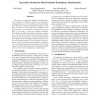Free Online Productivity Tools
i2Speak
i2Symbol
i2OCR
iTex2Img
iWeb2Print
iWeb2Shot
i2Type
iPdf2Split
iPdf2Merge
i2Bopomofo
i2Arabic
i2Style
i2Image
i2PDF
iLatex2Rtf
Sci2ools
DATE
2009
IEEE
2009
IEEE
Speculative reduction-based scalable redundancy identification
The process of sequential redundancy identification is the cornerstone of sequential synthesis and equivalence checking frameworks. The scalability of the proof obligations inherent in redundancy identification hinges not only upon the ability to cross-assume those redundancies, but also upon the way in which these assumptions are leveraged. In this paper, we study the technique of speculative reduction for efficiently modeling redundancy assumptions. We provide theoretical and experimental evidence to demonstrate that speculative reduction is fundamental to the scalability of the redundancy identification process under various proof techniques. We also propose several techniques to speed up induction-based redundancy identification. Experiments demonstrate the effectiveness of our techniques in enabling substantially faster redundancy identification, up to six orders of magnitude on large designs.
DATE 2009 | Hardware | Redundancy Identification | Redundancy Identification Process | Sequential Redundancy Identification |
| Added | 16 Aug 2010 |
| Updated | 16 Aug 2010 |
| Type | Conference |
| Year | 2009 |
| Where | DATE |
| Authors | Hari Mony, Jason Baumgartner, Alan Mishchenko, Robert K. Brayton |
Comments (0)

